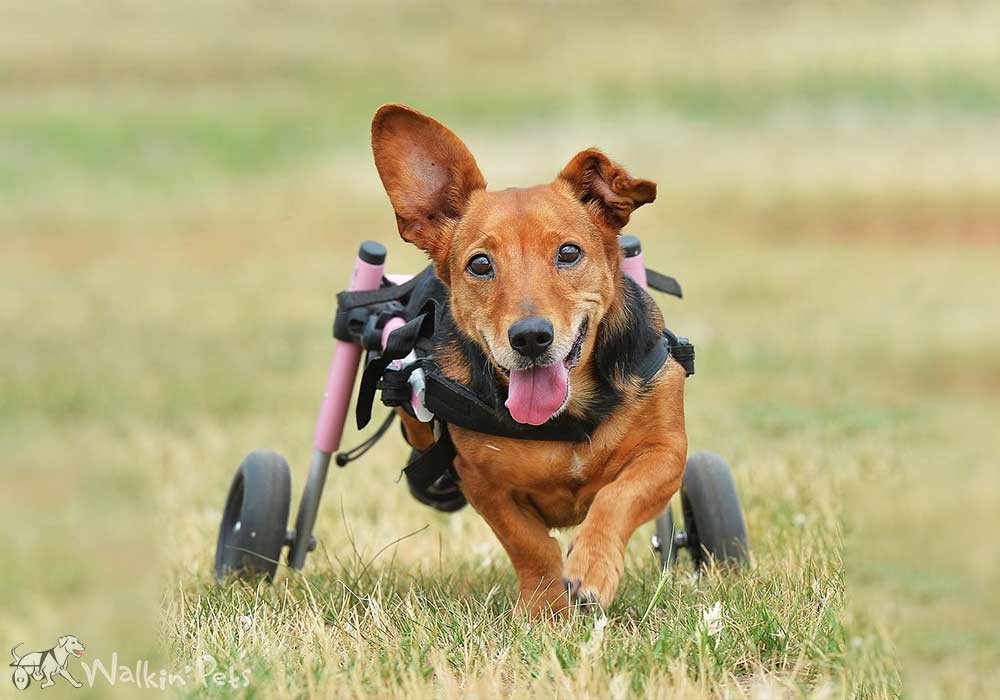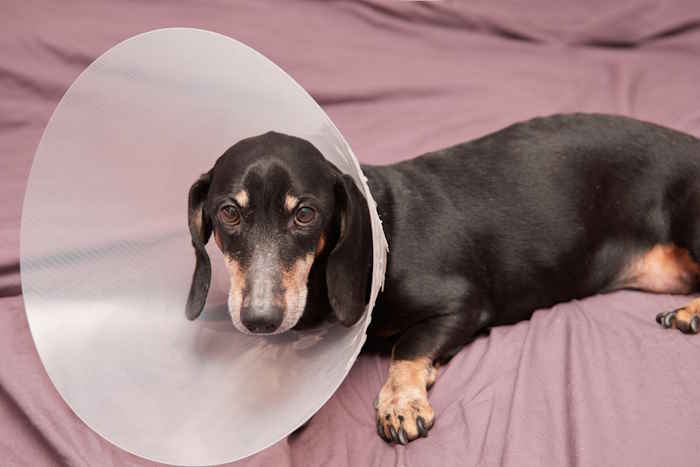- Small Dog Place Home
- Health
- Spinal Injuries in Dachshunds
Spinal Injuries in Dachshunds & Other Small Breeds: Practical Solutions to Serious Issues
Spinal Injuries in Dachshunds By Ellie Batchiyska
We love dachshunds for their adorable build: itty bitty legs supporting a spring-like body. However, the very characteristic that makes them lovable can also make them prone to back problems.
Dachshunds and other small dog breeds are predisposed to Intervertebral Disc Disease (IVDD) and similar spinal issues.
 Spinal Injuries In Dachshunds
Spinal Injuries In DachshundsSpinal Injuries in Dachshunds
Not only can IVDD and similar disorders impact your pet’s lifestyle, it can render them immobile. Several other small dog breeds are also at risk, including:
- Beagles
- Corgis (Pembroke Welsh Corgi) and (Cardigan Welsh Corgi)
- Cocker Spaniels
- Dachshunds (most common)
- Lhasa Apso
- Pekingese
- Shih Tzu
Spinal Injuries in Dachshunds: IVDD Symptoms & Causes
Fortunately, the symptoms of IVDD are pretty apparent, so it’s easy to catch the condition early. Furthermore, if you are a small dog owner, knowing your pet is susceptible to IVDD, and similar back problems will allow you to be more vigilant. Primary symptoms of IVDD include:
- Rear leg dragging
- Paw knuckling
- Altered gait
- Difficulty standing up
- Yelping or crying out in pain
- Hesitance to jump, move, play
- Decreased appetite and activity
- Incontinence
The small breeds mentioned previously are predisposed to IVDD because of their small stature, and the lack of support to their spine.
Onset can be genetically related, or as a result of injury. Sometimes, during playtime, a poorly landed jump could instigate a spinal injury. In this event, your dog will cry out, and you’ll usually know something has gone awry.
Solutions for Pets with IVDD

Spinal problems don’t have to leave your pet unable to enjoy life. There are tons of holistic, proactive, vet-recommended solutions to IVDD. Some of these require medical expertise, and some don’t.
Consider Acupuncture for Spinal Injuries in Dachshunds
You may think this sounds ridiculous, but acupuncture has been scientifically proven to aid pets, as well as people. IVDD causes neurological dysfunction, which can be targeted through various reflexology points. The key is to find a qualified, vet-referred, acupuncture specialist.
Electro-acupuncture (EAP) specifically has been studied by veterinarians. This involves sending electro-impulses through the needles to stimulate the muscles.
And, before you worry about whether or not this will cause your pet any discomfort, note that most dogs fall asleep during the treatment.
Recent studies showed that EAP when combined with Western medical treatments, helped dogs recover more quickly than traditional decompressive surgery.
For IVDD, the exact points targeted are the top of the spine by the shoulders and above the pelvis. In unison, targeting these two points with acupuncture are shown to improve the prognosis of dogs with IVDD.
Try physical therapy
There are plenty of physical therapy exercises for pets with spinal problems, especially if they’ve been rendered paralyzed or disabled as a result. The goal of physical therapy for IVDD is to provide a supervised and natural method of improving their range of motion.
If IVDD is caught early enough, physical therapy can even help your pet regain strength and movement in certain parts of their body.
Keep in mind that you should always consult with your vet about these exercises, and about the physical therapists, you plan to use, before embarking on this treatment.
Types of Physical Therapy
The primary physical therapy exercises used for pets with spinal problems are:
Hydrotherapy for Spinal Injuries in Dachshunds
This is perhaps one of the most effective physical therapy exercises. It involves letting your dog walk on an underwater treadmill. The buoyancy and weightlessness of the water eliminate any pressure on the joints while helping your dog re-establish muscle memory.
Massage
The physical therapist will massage your dog’s legs to improve circulation. They may also massage paw pads and shoulders. Once you observe them a couple of times, you can massage your pet at home too. Make sure to use very light, circular motions. Do not press hard.
Ball exercises
Place your pet atop a large exercise ball, with their paws draped over the sides. Hold your pet’s middle, so they don’t topple off, and roll the ball forward and back just slightly.
This exercise activates your dog’s instinct to reach for the ground. They will stretch their toes as a reflex, allowing them to regain some movement in their paws.
Resistance Exercises for Spinal Injuries in Dachshunds
This exercise involves laying your pet down on one side, and pushing on the bottoms of their feet. They will resist and push back. This exercise should only be performed by a professional, at least until you get the hang of it.
Passive range-of-motion
Similar to resistance, you’ll lay your dog on their side for this one. Instead, however, you’ll move their limbs for them. Mimic bicycling or walking motions, and it should improve their ability to walk on their own. This keeps your dog’s joints limber and flexible. Doing this twice a day for about 5 minutes each time will make all the difference.
Invest in natural supplements
There are plenty of safe, natural supplements you can give your dog to improve their strength. The same supplements that are traditionally used for arthritis can also be used for IVDD and spinal problems. Here are some natural supplements you can give them daily:
Turmeric
Turmeric helps reduce inflammation, which typically occurs in the spinal cord discs. When ground into a golden paste with pepper and coconut oil, it is most effective. You can mix it with your dog’s regular food, so they get their daily dose.
Phytoplankton
Over the last couple of years, fish oil has been revealed to be harmful for some pets. It contains toxins and radiation. Phytoplankton delivers the Omega-3 fatty acids without the toxic side effects. Omega-3s aid with joint health and inflammation.
CBD Oil
Hemp Pet owners are all talking about CBD oil. It contains practically no THC, so it’s entirely safe for your dog. Much like turmeric and phytoplankton, it reduces inflammation. Most importantly, however, it also significantly reduces pain and stress so that your pet doesn’t have to suffer.
Glucosamine
This naturally occurring compound helps repair cartilage. It also assists with the treatment of spinal disc injury. When used with chondroitin sulfate, it allows the cartilage between spinal discs to retain its spongy, moist nature – thus protecting them from further damage and abrasion.
Many of these supplements come as chews, while others come as powders you can sprinkle into your dog’s food. Their benefits are comparable to non-steroidal anti-inflammatory drugs (NSAIDs) while still being a natural alternative. In fact, NSAIDs can often involve other unfavorable side effects, such as gastritis and peptic ulcers.
Some experts even suggest that NSAIDs encourage the breakdown of cartilage, thus worsening arthritic symptoms. As such, they should only be taken for a very short period, if they’re taken at all for spinal injuries in Dachshunds.
Get them a wheelchair
Perhaps the best thing you can do for your pet with spinal problems is getting them a wheelchair. A pet wheelchair will help your four-legged friend regain their confidence and mobility, and there are several wheelchairs explicitly designed for dachshunds and small dogs.
As with anything, it will take your pet time to get accustomed to a wheelchair. They’ll have to adapt to their wider girth and less precise maneuvering, but it won’t take long. They’ll feel just like the other dogs in no time, and be able to wheel just as fast as they run.
You won’t want to plunge your dog right into life with a wheelchair, though. Start by letting them wheel around in 5-10 minute increments, a few times a day.
Take them on walks in the chair, and let them wheel around the house too. You may have to space out some of your furniture so they can navigate more easily. Wheelchairs can turn an ailing dog’s disposition around entirely, particularly when paired with other restorative treatments.
Other IVDD Solutions
Your pet’s spinal problems will result in some lifestyle changes. And, as time goes on, you’ll realize more and more new activities you have to adapt to their now-limited mobility.
For starters, getting up and lying down will be harder for them, so you may need to invest in a harness. Harnesses can also be used on walks, and to help them in/out of baths, as well as up/down the stairs.
With that in mind, you may also want to buy a ramp for wherever there are steps in your house. Pet ramps are usually compatible with wheelchairs and will allow them to expand their accessibility.
Most important of all is how you support your pet. Your positive attitude and encouragement are essential to your pet’s recovery. They can sense a calm and reassuring tone of voice, and it can make all the difference in how they approach their treatment.
Remember to praise your pet for seemingly small activities. Even short walks around the block will be a major feat for them now, so give that the attention it deserves. Give them treats to encourage more extended periods in their wheelchair, as well as longer walks.
Lastly, stay by your pet’s side during their visits to various physical therapists, acupuncturists, and vets. These can be nerve-wracking new experiences for them, and your presence is needed.
Your love goes a long way toward ensuring their health, and while you may be unable to heal those spinal injuries in Dachshunds, you can help your pet forget they’re there – even if just for a little while.
Spinal Injuries in Dachshunds By Ellie Batchiyska
 Ellie Batchiyska
Ellie BatchiyskaEllie Batchiyska is a writer for Handicapped Pets, the top manufacturer of pet wheelchairs.
She frequently profiles people, rescues, and tools that aim to help disabled animals.
When she’s not dispensing pet wellness advice, you can find her hiking, meditating, or adventuring with her dog.
About Janice (author and voice behind this site)
Having lived with dogs and cats most of her life, Janice served as a veterinary technician for ten years in Maryland and twelve years as a Shih Tzu dog breeder in Ohio.
Her education includes undergraduate degrees in Psychology with a minor in biology, Early Childhood Education, and Nursing, and a master's in Mental Health Counseling.
She is a lifelong learner, a dog lover, and passionate about the welfare of animals. Her favorite breed for over 50 years has been the Shih Tzu, but she has also lived with Poodles, Maltese, Yorkshire Terriers, Beagles, English Bulldogs, Carin Terriers, and a Cocker Spaniel.
When not writing, reading, and researching dog-related topics, she likes to spend time with her eight Shih Tzu dogs, husband, and family, as well as knitting and crocheting. She is also the voice behind Miracle Shih Tzu and Smart-Knit-Crocheting
Does This Article Deserve Your Thumbs Up?
We always appreciate your support and encouragement. Your thumbs up means so much to us. Please like this article.
If you find this page or any page on Small Dog Place Helpful, or useful in anyway, I'd love it if you would click the small heart found on the bottom right of each page.
You can also share or bookmark this page -- just click on the:

Free Monthly Newsletter
Sign Up for Our Free Newsletter and get our Free Gift to You.
my E-book, The Top 10 Mistakes People Make When Choosing a Dog (and how to avoid them)


